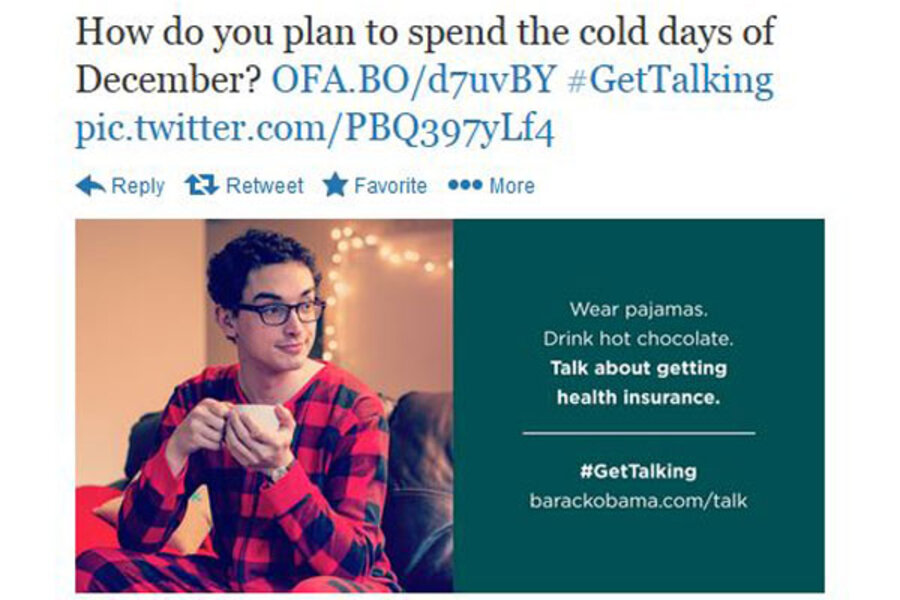'Pajama Boy' on Obamacare: Will Millennials hear a grownup in a onesie?
Loading...
| WASHINGTON
Have you heard about “Pajama Boy”? He’s in an ad tweeted yesterday by a political nonprofit associated with President Obama, wearing what appears to be a plaid onesie while cradling a hot beverage and looking to one side through arched eyebrows.
The point of the ad is to promote Obamacare among young adults. “Wear pajamas. Drink hot chocolate. Talk about getting health insurance,” says the ad copy.
The tweet adds its own kicker: “How do you plan to spend the cold days of December?” It includes a link to a website from the group, Organizing for Action, that includes information on how to talk to family members over the holidays about signing up for coverage under the Affordable Care Act.
Conservatives have had lots of hilarity with this ad Wednesday, poking at everything from the guy’s glasses and beverage choice to what some charge is his lack of traditional masculinity.
“A doofus in a plaid onesie drinking hot chocolate – is this really how the Obama administration pictures its supporters?” writes John Hinderaker on the right-leaning "Powerline" blog.
Then, New Jersey Gov. Chris Christie took a whack at pajama boy in a recent tweet.
Even liberals, who defend the ad overall, think its particular choice of image could be improved.
“Admittedly, the guy in the photo does look a little silly. That’s what happens when you wear a onesie!” writes Elias Isquith on the Salon site.
But we’ve got a question that’s more prosaic. What’s the idea here? How can this, you know, work?
The Obama administration is keen to get young adults – the so-called "young invincibles" – to sign up for Obamacare, of course. Younger people have generally lower health-care costs, and the revenue from their premiums is needed to offset the higher costs incurred by older beneficiaries.
And we get that this ad is meant to be ironic. At least, we think it’s meant to be ironic. That comes across more clearly in a companion ad where “Pajama Boy” is reclining in a leather sofa wearing a Christmas sweater and holiday socks. “And a Happy New Year with health insurance” says the ad’s copy.
But here’s the problem: not that many young adults are ironic, in our experience. Many of the ones that are, are also highly educated and live in urban areas, and are exactly the sort of high-information voters who already know all about the Affordable Care Act’s requirement that individuals buy health insurance.
Plus, true hipsters are likely making fun of this guy. Have you seen hipsters lately? Lots of them wear beards. They look Amish.
Maybe the outlandishness of the portrayal is supposed to make the photo go viral and spread the word by sheer repetition, as if it were a funny cat gif imbued with a serious message. If so, mission accomplished!
However, to us it seems like lots of the advertising aimed at young adults on health care from both sides is condescending. There are the “brosurance” ads from ProgressNow Colorado, which use frat boy images to push the idea that young adults need health care to pay for injuries incurred while drinking, for instance.
On the other side of the issue, there are the infamous “Creepy Uncle Sam” ads, which use a big-head Uncle Sam figure to try and convince young adults that getting insurance through the government is a bad idea.
The actors in these ads are mid-20s. That’s an age where you can be a captain in the Army, or a foreman on a contracting crew, or a physics teacher in a big high school. To many Millennials, ads pushing a serious subject that also feature keg stands or a guy in a scary costume may not connect.
“The problem with these campaigns – with all the Invincible-targeted ads in the Obamacare muddle, actually – is twofold. First they don’t inform all that much.... Second, there’s very little respect for the intended audience,” wrote the Atlantic Wire’s Alex Edelman of the “brosurance” and “Creepy Uncle Sam” campaigns in November.
“Pajama Boy” might not be as far up the condescension scale. It’s still kind of weird. On Buzzfeed, McKay Coppins theorizes that the ambitious young folks in politics that get put in charge of youth outreach efforts don’t really understand their generational peers. They’re in politics, after all.
“Is there any battle in contemporary politics being waged with more indignity and less prowess than the tug-of-war for twentysomethings over Obamacare?” Mr. Coppins writes.






